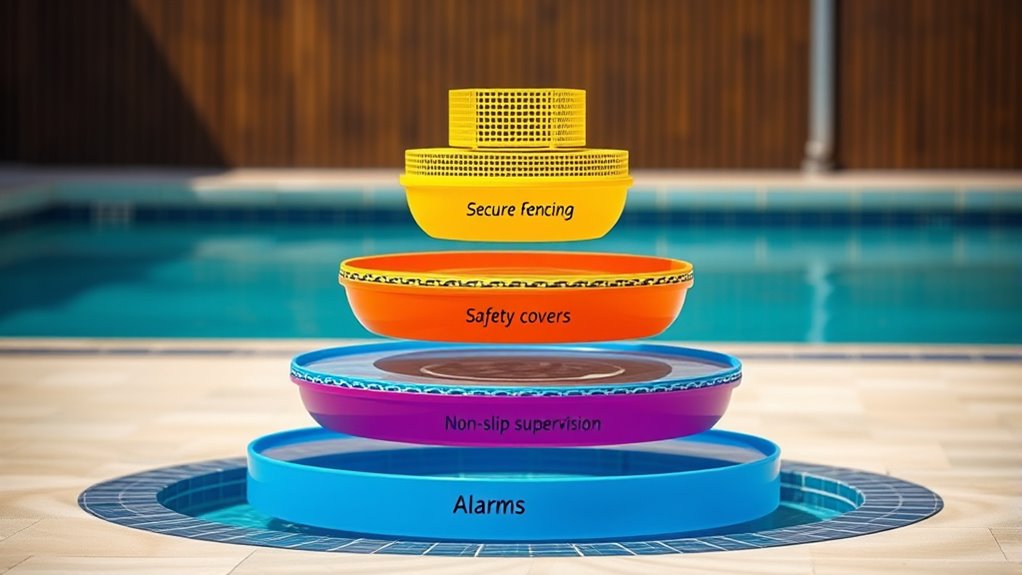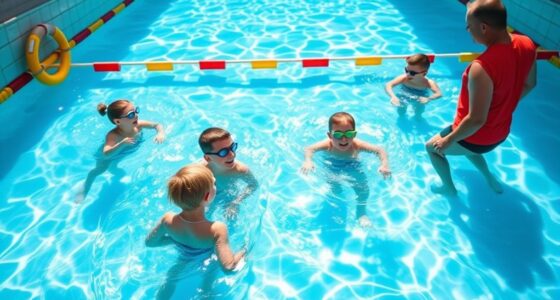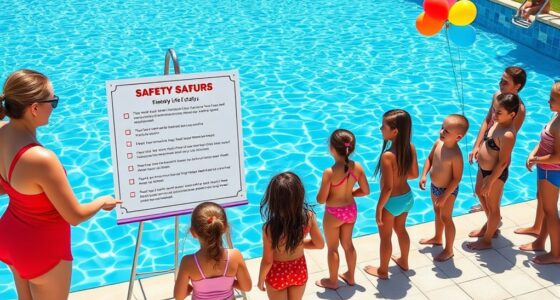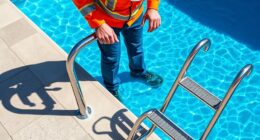To understand the pyramid of pool safety, recognize that it’s built on layered protection strategies: supervising swimmers with trained lifeguards, managing chemicals properly, installing physical barriers and clear signage, educating users about safe practices, and preparing for emergencies with drills and accessible equipment. These layers work together to prevent accidents and respond effectively if they occur. If you keep exploring, you’ll discover how combining these elements creates an all-encompassing safety system that keeps everyone secure.
Key Takeaways
- The pyramid emphasizes multiple safety layers, including supervision, barriers, signage, education, and emergency preparedness.
- Strong supervision with trained lifeguards provides immediate response and deters unsafe behavior.
- Physical barriers and clear signage restrict access and communicate safety rules effectively.
- User education through swim lessons and safety briefings enhances awareness and personal responsibility.
- Regular emergency preparedness drills ensure effective response and reinforce safety protocols across all layers.
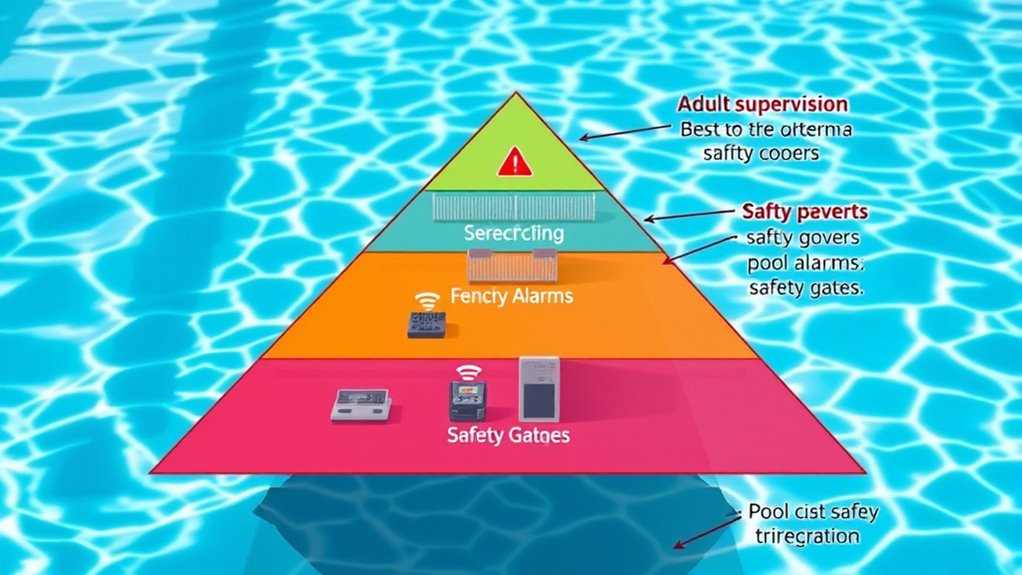
Ensuring pool safety is essential, and understanding the Pyramid of Pool Safety can help you take effective steps to protect everyone. This layered approach emphasizes multiple safety measures working together to minimize risks and prevent accidents. The foundation of this pyramid typically includes strong supervision, such as having trained lifeguards on duty. Lifeguard training is crucial because it equips staff with the skills to recognize and respond swiftly to emergencies, whether it’s a swimmer in distress or a sudden injury. Properly trained lifeguards maintain constant vigilance, enforce safety rules, and can initiate rescue procedures immediately. They also serve as a visible safety presence, which discourages reckless behavior and reassures swimmers that help is nearby if needed.
Strong supervision with trained lifeguards is the foundation of pool safety, ensuring swift response and visible reassurance for swimmers.
Building on supervision, the next layer involves pool chemical safety, which is vital for maintaining a healthy and safe swimming environment. Proper handling, storage, and monitoring of pool chemicals prevent hazardous situations like chemical spills, skin or eye irritations, or the development of harmful bacteria. You should ensure that chemicals are stored securely, labels are clear, and staff are trained in safe chemical management. Regular testing of water chemistry ensures optimal pH and sanitizer levels, reducing the risk of waterborne illnesses. Combining chemical safety with effective supervision creates a safer environment, where potential hazards are minimized before they escalate.
Beyond supervision and chemical safety, the pyramid emphasizes physical barriers such as fences, safety covers, and alarms. These act as secondary defenses, preventing unsupervised access to the pool area, especially by children. Proper signage also plays a critical role by clearly communicating rules and safety guidelines, reminding pool users of safe practices. Education and training for pool users, including swim lessons and safety briefings, further strengthen this layered protection. These efforts empower swimmers to recognize dangers and respond appropriately, reducing reliance solely on physical barriers or supervision.
Lastly, emergency preparedness ties all these layers together. Having clear rescue procedures, first aid kits, and accessible communication devices ensures that if an incident occurs, you’re ready to respond effectively. Regular drills and staff training reinforce this readiness, making sure everyone knows their role in safeguarding pool visitors. When all these layers—lifeguard training, chemical safety, physical barriers, user education, and emergency preparedness—work in unison, they create a comprehensive safety net. Additionally, integrating sound design principles into emergency signals can improve communication clarity during critical moments. Understanding the Pyramid of Pool Safety enables you to implement and maintain these strategies, providing peace of mind that you’re doing everything possible to keep your pool safe for everyone.
Frequently Asked Questions
How Do Different Age Groups Require Tailored Pool Safety Measures?
You need to tailor pool safety measures based on age groups by ensuring constant child supervision for young children, who are most vulnerable. Install age-appropriate barriers, like fences and self-closing gates, to prevent unsupervised access. For teens, focus on education about pool risks and enforcing rules. Older adults might require easy-access safety equipment. Adapting safety strategies for each age group helps you reduce accidents and create a safer swimming environment.
What Are the Latest Technological Innovations in Pool Safety?
Did you know that smart sensors and predictive technology now improve pool safety considerably? These innovations detect motion, monitor water conditions, and alert you instantly to potential dangers. You can enjoy peace of mind knowing that modern safety systems proactively prevent accidents. Incorporating these technologies into your pool setup ensures real-time responses, making your pool safer and smarter. Stay ahead with the latest safety innovations that protect your loved ones every time you swim.
How Does Weather Impact Layered Pool Safety Strategies?
Weather hazards markedly impact your layered pool safety strategies. Rain, wind, and storms can reduce visibility, create slippery surfaces, and increase drowning risks. You should make seasonal adjustments by installing weather-resistant barriers, enhancing supervision during adverse conditions, and ensuring safety equipment is easily accessible. Always stay alert to weather updates and modify your safety measures accordingly, so you can keep everyone safe despite changing weather hazards.
What Legal Requirements Support the Pyramid of Pool Safety?
Liability laws and safety regulations support the pyramid of pool safety by mandating specific safety measures like fencing, alarms, and supervision. These legal requirements hold you accountable if proper precautions aren’t in place, encouraging you to implement multiple protection layers. Following these laws not only reduces your liability but also guarantees a safer environment for swimmers, reinforcing the importance of layered safety strategies to prevent accidents.
How Can Community Programs Enhance Layered Pool Safety Efforts?
Think of community programs as the safety net that catches kids before they hit the water. Your involvement boosts community engagement, making safety messages stick. Securing program funding guarantees pools have lifesaving equipment and trained staff. For example, a neighborhood that hosts free swim lessons and safety workshops drastically reduces drownings. By supporting these efforts, you strengthen the layered protection, turning a risky environment into a safe, enjoyable space for everyone.
Conclusion
By following the layered protection strategies in the pyramid of pool safety, you’re building a strong shield around swimmers. Remember, safety isn’t a one-time effort but a continuous process—like a chain is only as strong as its weakest link. Stay vigilant, use multiple safety measures, and you’ll create a safer pool environment. After all, a stitch in time saves nine, so invest in safety today to prevent accidents tomorrow.
